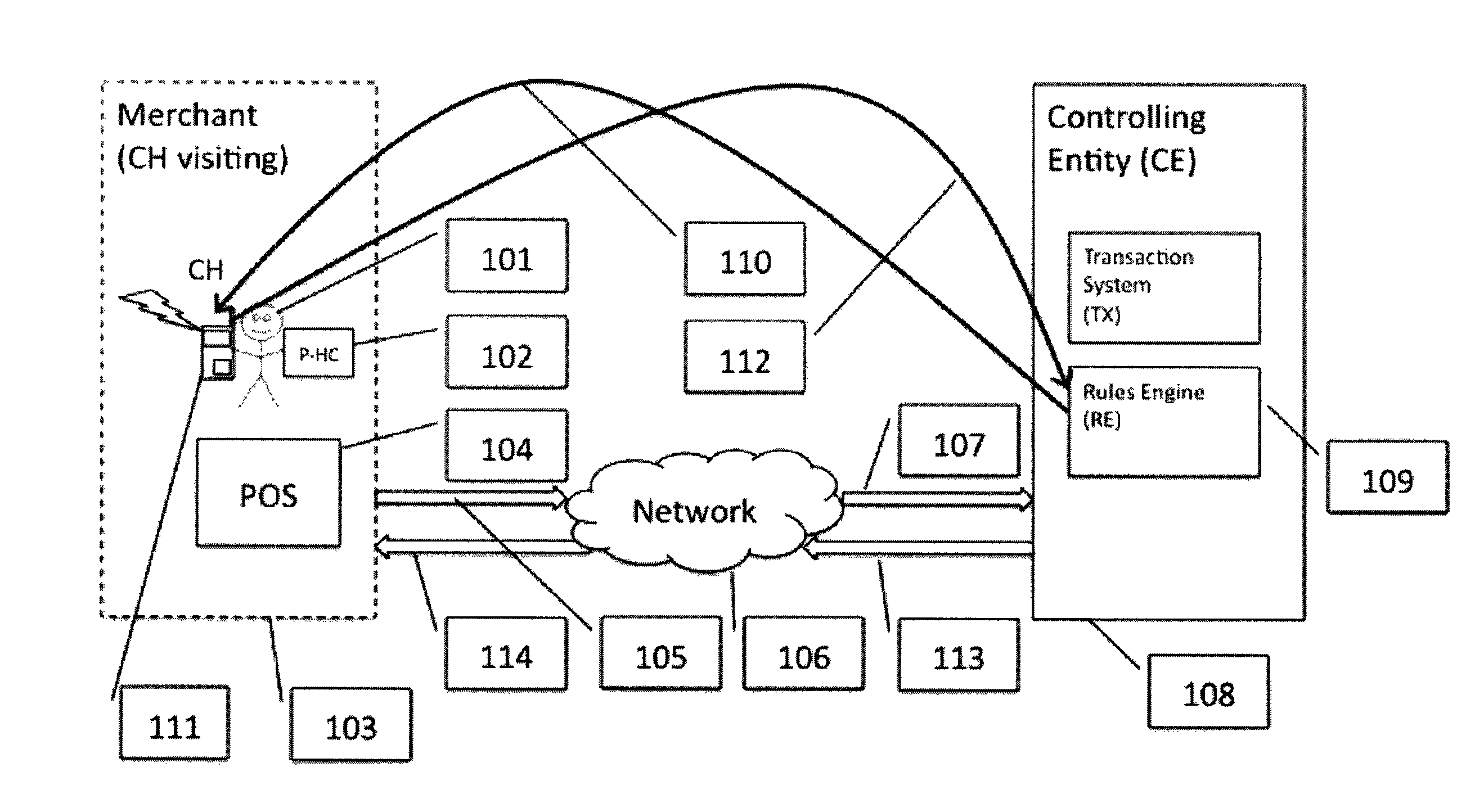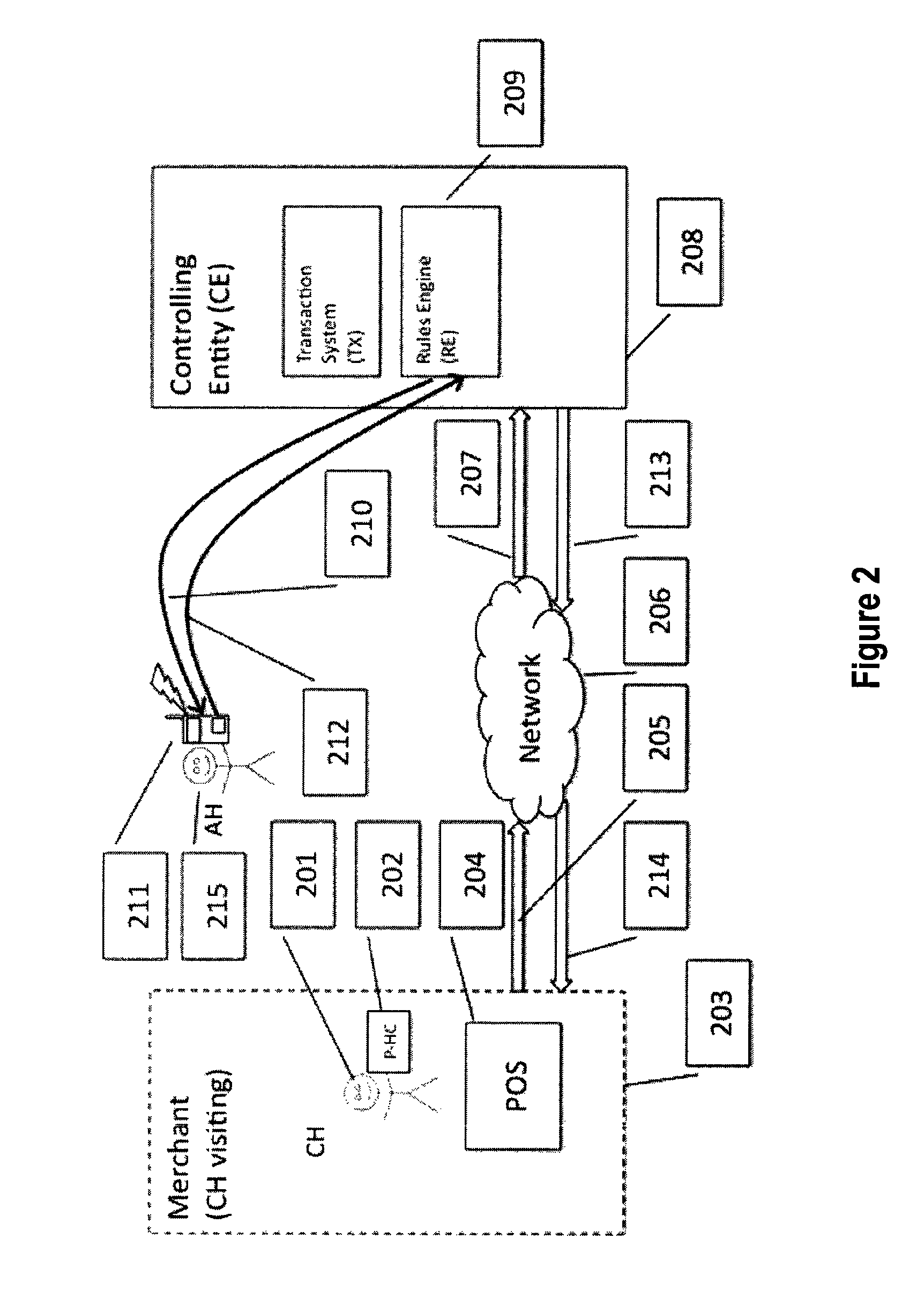Adaptive transaction rules system
a transaction rule and transaction rule technology, applied in the field of payment systems, can solve the problems of no user experience, no mechanism that the cardholder can use to actively limit card usage, and cardholders or account holders cannot help enforce legitimate use of their or their cards
- Summary
- Abstract
- Description
- Claims
- Application Information
AI Technical Summary
Benefits of technology
Problems solved by technology
Method used
Image
Examples
example 1
[0016]A CH 101 has configured a card rule set (including rule “RS1”) so that every first-time transaction at a new merchant 103—one at which the card 102 has never previously been used for transactions—must be approved by the CH 101 via mobile phone. In this scenario, the CH 101 proceeds to the merchant 103 and begins a transaction with a typical card swipe. The CE 108 sees the incoming transaction authorization request and the RE 109 notes that this is a request from a merchant 103 at which this card 102 has never been used. Following the rule RS1, the RE 109 requests from the CH 101 verification that this merchant 103 is acceptable (via request for information 110 and response 112 of FIG. 1). If the CH 101 responds that the merchant 103 is acceptable, the RE 109 adds this merchant 103 to the known-merchants list for this card 102, thus changing the parameters of operation of RS1 for this CH 101.
example 2
[0017]A CH 101 has configured a virtual card 102 so that it will be usable only at one particular on-line merchant 103, and has declared that the first transaction on the card 102, to be no more than 1 hour from the current time, will come from the merchant 103 (rule “RS2”). The CH 101 then begins a transaction with the merchant 103. The RE 109 notes this transaction request and communicates with the CH 101 in order to verify that this is, indeed the merchant 103 to which the card 102 should be locked. Utilizing the CH's response, the RE 109 updates the parameters of operation of RS2 so that the card 102 is usable in the future only at this merchant 103. Alternatively, the RE 109 may delete RS2 altogether and create a new rule RS3, which specifies that the card 102 is locked to the relevant merchant 103.
example 3
[0018]An AH 215 (FIG. 2) has created a card 202 for use by the AH's child at college; the child will be the CH 201. The rules set includes a rule RS4, which alerts the AH 215 to any purchases made outside the geographical boundaries of the college campus. At one point in time, CH 201 makes a purchase at a grocery store 203 outside campus; AH 215 is notified (shown by communication 210 in FIG. 2). Part of the notification is a request—asking AH 215 if future purchases at this retailer 203 should be, for example, always allowed, allowed only when pre-approved by AH 215 or always denied. AH 215 replies with “always allow,” at which point RE 209 alters the parameters of operation of RS4 (or deletes RS4 and inserts a new rule RS5) in order to allow purchases at this grocery store 203 in the future, without further alerts being delivered to AH 215.
Mobile Interactions
[0019]Mobile interactions may be an effective mechanism for obtaining CH and / or AH input for rule set adaptation. While user...
PUM
 Login to View More
Login to View More Abstract
Description
Claims
Application Information
 Login to View More
Login to View More - R&D
- Intellectual Property
- Life Sciences
- Materials
- Tech Scout
- Unparalleled Data Quality
- Higher Quality Content
- 60% Fewer Hallucinations
Browse by: Latest US Patents, China's latest patents, Technical Efficacy Thesaurus, Application Domain, Technology Topic, Popular Technical Reports.
© 2025 PatSnap. All rights reserved.Legal|Privacy policy|Modern Slavery Act Transparency Statement|Sitemap|About US| Contact US: help@patsnap.com



